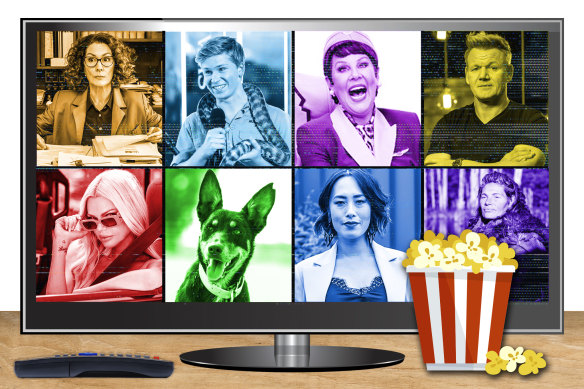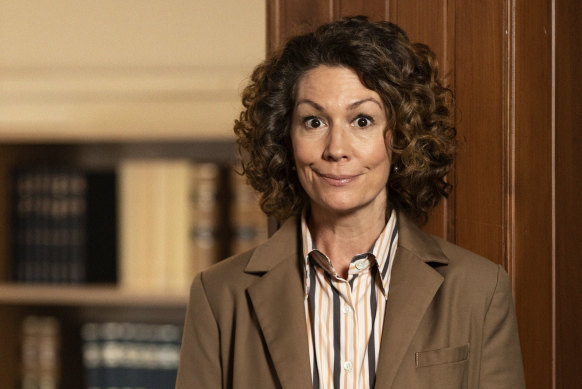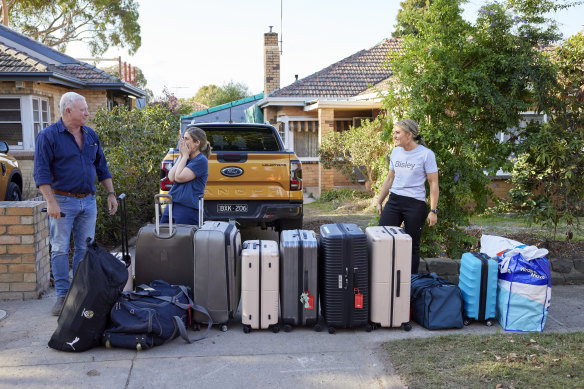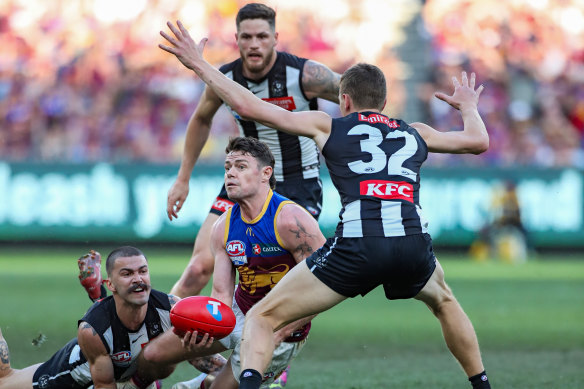By Karl Quinn
The networks’ offerings for 2024 will look much like their offerings in 2023. Credit: Artwork by Monique Westermann
Save articles for later
Add articles to your saved list and come back to them any time.
As the TV networks recently embarked on their annual round of razzle-dazzle, outlining their biggest shows and upcoming slates, a picture of the Australian television landscape began to emerge.
At the events, known as the upfronts, they all did their best to convince ad buyers and the media that the year to come will be bigger and better than ever, and unlike anything that has ever come before. And in a sense they were right: collectively, Australian TV is at a huge tipping point.
But what the upfronts made abundantly clear is that the changes are much more about technology and what that means for the way we consume television than they are about the content itself – at least for now.
“I feel we just have to recognise that audiences have gone to on-demand, and so we just have to be there as well,” ABC chief content officer Chris Oliver-Taylor told this masthead on the eve of the broadcaster’s presentation earlier this month.
The ABC’s most popular comedy ever, Fisk will return for a third season in 2024.Credit: ABC
In other words, the days of the scheduled ABC TV offering being the principal mode of broadcast, with streaming on iview a supplement, were over.
It’s not just the ABC either.
Paige Wheaton, chief investment officer at media buyer Initiative Australia, didn’t attend the ABC upfront – with no ad space for sale, it is irrelevant to her clients – but she was at all the others. And what she saw and heard left her convinced that we are rapidly approaching the moment when the physical transmitters that have underpinned broadcast television in this country for decades will be turned off, perhaps within five years, as the industry shifts to a purely digital and streamed mode of distribution. And that will fundamentally reshape what TV looks like.
“We’re at a pretty critical inflection point where the fight for that post-linear viewer is very much in play,” she says. “And if you look at the likes of SBS and Foxtel, their digital penetration and share of audience far exceeds that of their linear broadcast. So we’re already starting to see that trend.”
The Block will return for a 20th season, as Nine and the other networks lean heavily on the familiar in 2024.
What this will mean for consumers down the line will be personalised advertising, as the broadcasters and media agencies use your personal log-in details, past viewing habits, location and spending preferences to sort the marketing wheat from the chaff. In theory, that means you won’t be subjected to endless ads for stuff you have no interest in. And for the advertisers, it means they won’t be spending money with little chance of financial return to hit those people.
One of the biggest announcements came from SBS, which revealed it would give viewers the ability to opt out of certain types of advertising content on its On Demand streaming platform – including gambling.
“And I think we’ll start to see that more and more as we have the ability to be more personalised,” says Wheaton. “At the moment, we’re reaching one-to-many with an advertisement, and what it will become is one-to-the-right-many.”
Each of the five free-to-air broadcasters and Foxtel held upfront presentations (none of the streamers did, which arguably tells its own story about how they see their roles in the Australian television landscape). And each adopted a style and format suited to the message it was trying to sell.
The ABC kept its event frugal, with a well-crafted presentation to a small audience in its studio in Ultimo, but it had far more to offer in terms of dramas (six) and comedies (four) than anyone else. Most, though, were returning shows: Total Control, The Newsreader, Fisk, even a local spin-off to the BBC series Death in Paradise (in the non-scripted space, new seasons of Grand Designs Australia and Muster Dogs led the charge).
Seven has secured digital streaming rights for the AFL and cricket in 2024.Credit: Paul Rovere
Seven used the tech-focused SXSW event in Sydney to position itself as innovative in the digital space, as it made much of the fact it will next year offer live-streaming of cricket and AFL for the first time. Nine had a party at which the house band was The Presets, while its programming line-up leaned heavily on the tried and trusted formula of travel (Travel Guides, Getaway), home and garden (The Block, Space Invaders, new show The Garden Hustle), relationships (MAFS, Parental Guidance), and crime.
Paramount (aka 10) did six presentations to small groups of media buyers in Sydney to emphasise the targeted nature of its offering, which leans heavily on returning formats such as MasterChef, I’m a Celebrity … Get Me Out of Here and Survivor. It also took the opportunity to talk up the new space of FAST (free ad-supported television), in which it is the local market leader, with 51 programmed digital channels offering endless streams of specialised content (everything from Happy Days to MasterChef to Christmas movies) to niche audiences.
Melissa Leong will appear on both Network 10 and SBS in 2024.Credit: Eddie Jim
SBS threw a lavish lunch at Sydney Town Hall, wheeling out Adam Liaw, Melissa Leong and winner of Alone Australia Gina Chick to throw a spotlight on its diversity. And Foxtel took over the former industrial precinct of Cockatoo Island, using its night to launch a broadside at the ratings system Oztam and announcing its streaming app aggregator Hubbl (which some observers were quick to point out offers little beyond what is already available on Fetch and some smart TVs).
In short, the presentations were bigger on technology and targeting than they were on innovative programming.
“We can see in some of the announcements a high degree of risk-aversion, which is appearing in a heavy reliance on formats or re-boots across different genres,” says Matthew Deaner, chief executive of Screen Producers Australia. There was a danger, he adds, that such risk aversion “can easily become a self-fulfilling negative prophecy for media platforms – particularly if they aren’t engaging in relevant and well-made content for children or youth audiences, and there is not a lot that is going on here unfortunately.”
“It’s very safe, there was not much risk-taking at all,” agrees media buyer Dave Levett of Murmur. “Macro-economic pressures are obviously affecting ad revenues and budgets, so advertisers are looking for more safe bets, they want to find content they know works. So there’s less appetite, then, for the broadcasters to invest in new content, because they’ve got their safe bets and that’s what they want to be able to sell.”
One experienced local producer, who spoke on the condition of anonymity because they do not much like the smell of burning bridges, bemoans the “desert of locally commissioned programming” on Australian television outside of sport – which is increasingly important as one of the few remaining bastions of “appointment viewing” – and reality TV.
But, they add, the diminished appetite for risk is entirely understandable.
“There’s fewer timeslots, so there’s less programming real estate overall,” they say. “There used to be first-run drama and entertainment at 9.30pm, game shows at 5 and 5.30, a midday show, breakfast and morning shows that were really well resourced.
“Now you’ve got slightly different iterations of strict Monday to Friday programming blocks, with one show owning that slot all week, then a show after that and maybe one more after that.”
In that environment, they ask, “where do you take a risk? Every show is existential. Risk-taking is the least rational thing for a free-to-air programmer to do right now.”
The steady erosion of scripted content across the networks is partly down to the paid streamers who have built up an audience that wants to watch when they want to watch, without the interruption of ads.
“I don’t think the networks have a philosophical objection to it,” the producer adds. “If Australians would watch drama in the commercial schedule, they’d be making tonnes of it.”
Meanwhile, the streaming platforms are starting to take fewer risks. “The disruptors are beginning to act like old-school broadcasters,” the producer says. “It was inevitable after their brand-building phase, but we are in danger of being left with structurally disrupted FTA platforms, and a replacement that is essentially a membership to America’s DVD library.”
Contact the author at [email protected], follow him on Facebook at karlquinnjournalist and on Twitter @karlkwin, and read more of his work here.
Find out the next TV, streaming series and movies to add to your must-sees. Get The Watchlist delivered every Thursday.
Most Viewed in Culture
Source: Read Full Article





